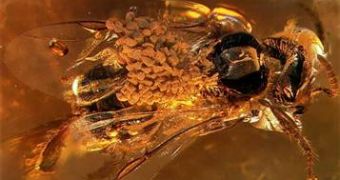We do not know if dino lover boys used them to impress their girls, but dinosaurs surely enjoyed orchids before their demise, as revealed by a newfound fossil.
A block of amber (fossil resin) encasing an extinct, stingless bee (Proplebeia dominicana) carrying a clump of orchid pollen on its back shows that these "masterpieces" among flowers appeared sometime between 76 million and 84 million years ago, much earlier than previously believed.
"Our analysis places orchids far toward the older end of the range that had been postulated, suggesting the family was fairly young at the time of the extinction of the dinosaurs some 65 million years ago," said lead author Santiago Ramirez of Harvard's Museum of Comparative Zoology and Department of Organismic and Evolutionary Biology.
The new fossil was first found by a private collector in the Dominican Republic in 2000, but the first lab tests were made in 2005 by a team led by Ramirez.
The location and shape of the pollen clump allowed the classification of the ancient orchid, named Meliorchis caribea, within one of five living lineages of orchids.
The bee got the pollen through active pollination, not a random encounter and for placing the pollen clumps to the bee's back, the orchid bloom should have evolved a bent anther (the pollen-producing flower part).
The fossil itself was 15- 20 million years old, but the fossil orchid DNA could be compared with DNA from living orchid species. This way the researchers calculated a molecular-clock, which assessed how long 2 or more lineages have been evolving independent of one another. It appeared that some types of modern orchids evolved very early: for instance, the genus Vanilla (from which vanilla is obtained) emerged about 60-70 million years ago. After the dinosaurs became extinct, 65 million years ago, the orchid species started to diversify.

 14 DAY TRIAL //
14 DAY TRIAL //